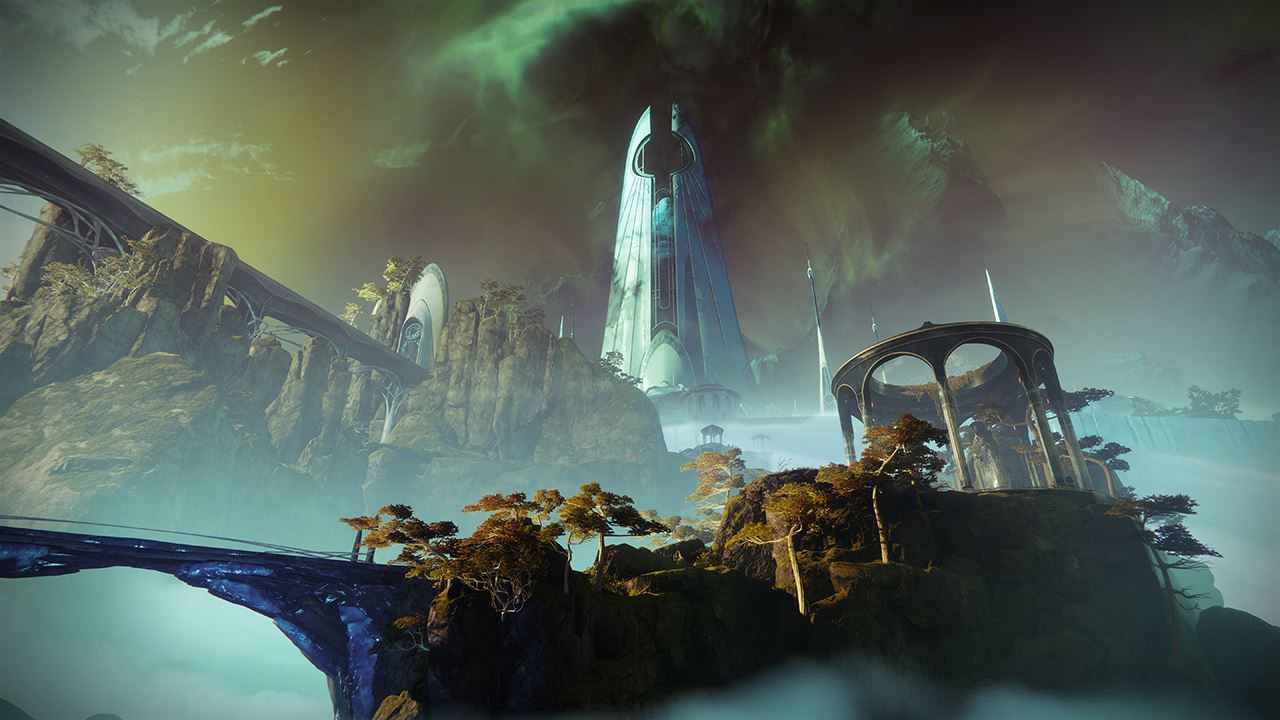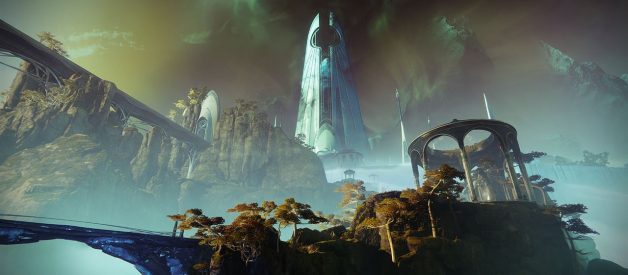 The Dreaming City in Destiny 2: Forsaken (2018)
The Dreaming City in Destiny 2: Forsaken (2018)
The article was originally published in video form on Sep. 23, 2019, by Subpixel. Minor alterations have been made to reflect the ongoing development of the Destiny franchise.
Now that we?re several months into the launch of Destiny 2: Shadowkeep, I wanted to take a minute to talk about The Dreaming City ? Bungie?s magnum opus when it comes to Destiny.
The first environment of its kind within the franchise, Destiny 2: Forsaken?s Dreaming City is an organic, living environment that evolved as the game went on (and perhaps isn?t quite done evolving yet), allowing for a more immersive and compelling player experience than we?d ever seen in Destiny.
This organic evolution was implemented in a variety of ways, from the smallest of details to the huge skyboxes that surround the city itself.
Now back in September of 2018 during the first week and a half of Forsaken?s release, The Dreaming City was just like any other patrol zone: small groups of enemies wandering about, a handful of lost sectors to explore, special regions chests in hard to reach or hidden locations, and myriad actual patrols to help the Awoken reclaim their City. There were more secrets and unexplained areas hidden around the City than in most other patrol areas, but it was still for all intents and purposes the same as everything we?d seen before.
But then came the raid.
In the marketing push leading up to Forsaken Bungie repeated time and again that the Dreaming City would change based on players? actions within the game. But just how exactly would that happen in the game? Would it be a matter of instancing like in World of Warcraft, where after completing certain activities, certain environments look and behave differently for players who have completed the appropriate tasks? That was my best guess, that the Dreaming City would undergo essentially what amounted to cosmetic changes, and maybe introduce new vendors as players completed activities (somewhat like the Farm during the main campaign of Destiny 2). But I was only half right, and mostly wrong.
When the first Fireteam cleared the monstrous Last Wish raid, something happened: the raid completion triggered a pre-ordained series of events that twisted everything I knew about Destiny?s gameplay loop on its head. The Dreaming City was Taken.
Now without getting too much into the pages and pages of Destiny lore that lead up to this event, I will say that what happened then and is still occurring right now in the Dreaming City is a satisfying fulfillment of years of worldbuilding and foreshadowing on Bungie?s part.
So what then makes this new version of The Dreaming City so spectacular?
Destiny?s content ebbs and flows on a weekly cycle, and so does The Dreaming City. But unlike the seemingly RNG(Random Number Generator)-oriented rotation of the rest of Destiny?s weekly activities, the content cycle of The Dreaming City is markedly cyclical, clearly repeating itself in three week rotations. This, in the lore of Destiny, is the curse upon The Dreaming City ? as initiated when the first fireteam cleared Last Wish. As each new week passes the City undergoes not only subtle aesthetic changes (as I predicted), but your Awoken contact in the Dreaming City, Petra Venj, moves around the City to a different location each week ? setting her apart from every other planetary vendor (with the special exception of the exotic salesman Xur, who also travels from planet to planet to hock his wares, but he?s a special case). Now this vendor placement may seem like a small and insignificant change from week to week, but it adds an extra layer of narrative depth to the saga of The Dreaming City and plays logically into the weekly activities available to you, specifically the weekly missions specific to that week of the curse cycle.
In the first week of the cycle Petra appears in The Strand, and tasks players with searching for a wounded Awoken Corsair; but in next she meets players out in the Divalian Mists, where players first arrived in the Dreaming City after the conclusion of Forsaken?s campaign. The third and final week of the Dreaming City?s taking finds Petra out in Rheasilvia looking out over the City?s Harbinger?s Seclude, the area players will explore in that week?s post-Raid weekly mission.
It?s these small details of NPC placement that lend that extra hint of realism to the world of The Dreaming City.
Additionally, things like the enemy spawns throughout the City change from week to week. Their locations remain the same, but the enemies that spawn there cycle from week to week, adding a neat variety to any journey through the City. A series of six specialty encounters called Ascendant Challenges rotate throughout the City on a six week cycle, accessible in specific but hidden locations. The Dreaming City?s Blind Well, a horde mode similar to Warmind?s Escalation Protocol or Rise of Iron?s Archon?s Forge, also changes from week to week. The mechanics of the well are the same each week, but the enemies and bosses are determined by the intensity of the curse during that specific week. Completing the Blind Well enough times would also award players with an Oracle Offering, which they could use to send messages to the lost Awoken queen.
But the pinnacle of The Dreaming City?s activities, both in terms of gameplay and the canon of Destiny?s worldbuilding, is The Shattered Throne. The first of its kind in Destiny, The Shattered Throne is what the devs at Bungie call a dungeon. Not quite as brutal as a raid but definitely more challenging than a Nightfall strike, The Shattered Throne emerged during the third week of the City?s curse cycle ? at the curse?s greatest intensity ? and allowed players to traverse the ruins of the Awoken queen?s throne world and kill what many believed at the time to be the source of the City?s curse. But the curse persisted. At the next weekly reset the City returned to its state immediately post-Last Wish completion. But as players returned and began completing the City?s activities once again, they noticed that Petra Venj and the other Awoken scattered around the City?s dialogue was different. The missions and patrols were the same, but the voice acting changed to reflect the repetition of the cycle.
And as the weeks passed, and players settled into the rhythm of the City?s weekly activities, they continued to find the characters in The Dreaming City reacting anew to the cycle upon their City. The most obvious example of this continued worldbuilding was during player?s visits to the Queen?s Court, an environment accessible during the third week of the circle cycle, similar to The Shattered Throne. The same week players first discovered The Shattered Throne, they also discovered that the Oracle Engine, which they?d been using for two weeks to send messages to Queen Mara, was in fact a portal to the Queen?s Court, where for the next several months players could visit to speak directly to the Awoken Queen. Each monthly visit to the court revealed some new information about the world of Destiny, and eventually culminated in the Queen?s departure from the court. Nowadays if you visit, all you?ll find is an empty throne.
All this served to establish The Dreaming City not only as the most interesting week-to-week environment in Destiny?s history, but also the most thoughtful. Every other environment across both Destiny games has been, for the most part, static. The closest we?d seen before then in terms of environmental evolution in Destiny was the snow covered Cosmodrome in Rise of Iron ? setting that Russian setting apart from the more arid version players had become familiar with during the two previous years of Destiny?s existence. But even this new version of the Cosmodrome was a static space. It is the same now as it was for Rise of Iron?s release.
The Dreaming City is Destiny?s most fully-realized location, both in terms of variety of activities and in-universe lore. The Dreaming City is the culmination of years of worldbuilding as well as the setup for an unknowable amount of future story beats. It?s this kind of dedication to the world of Destiny that made me so incredibly excited for Shadowkeep and the third year of Destiny 2. According to Destiny?s Game Director Luke Smith, the future of the world of Destiny will look very much like what we?ve seen in The Dreaming City. He had this to say about the new seasons of content that arrived and will arrive with Shadowkeep?s release in October of 2019:
?Everyone who plays Destiny will be able to see how the world is different and changing during the Season ? the goal is that everyone will be involved in how the world changes.
And at the end of the Season, your collective actions will have caused the world state to change. Doing this allows us to evolve the world ? narratively, but potentially physically as well. It is not possible to keep Destiny frozen in place to allow all activities to live forever while also changing the world in meaningful ways ? We believe that Destiny will grow even better when the world state can change, and that the best Destiny stories are the ones where ?you had to be there when?.??
He goes on to describe further changes to the Seasonal model of Destiny that sound to me a lot like Bungie is making the whole game much more like The Dreaming City. Things will come and go. The world will change ? permanently. And I?m all for it. I can?t wait to see what Destiny brings us next.


